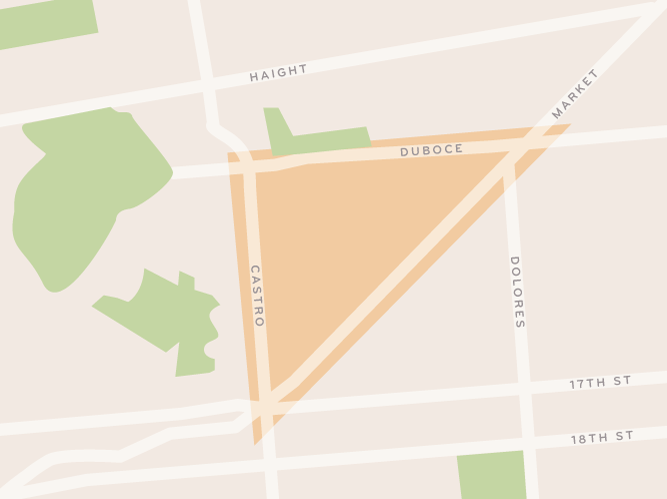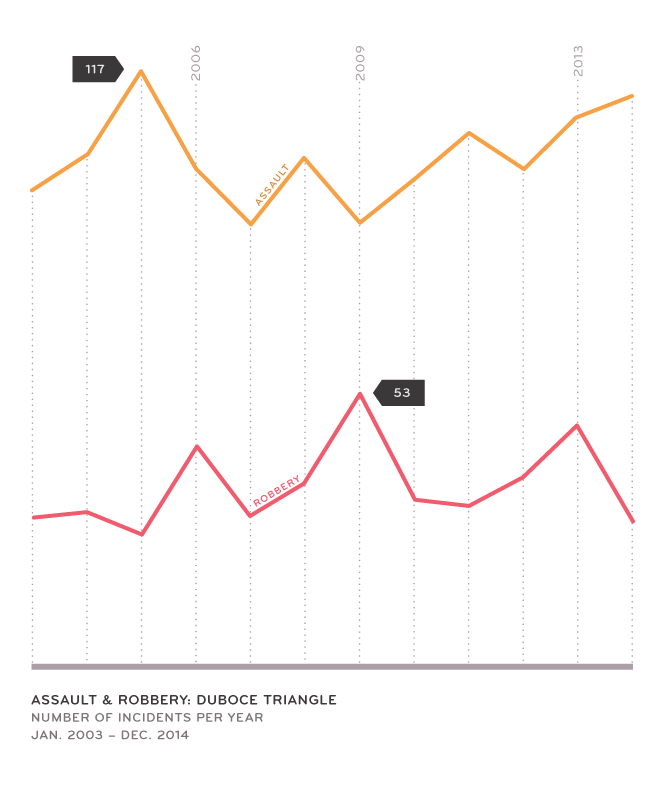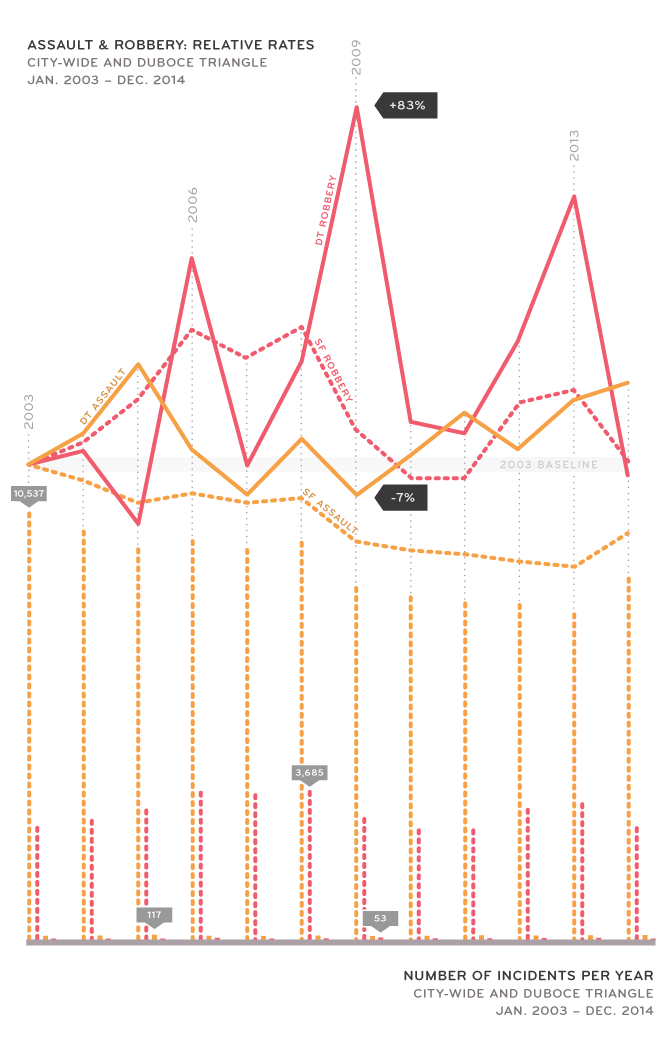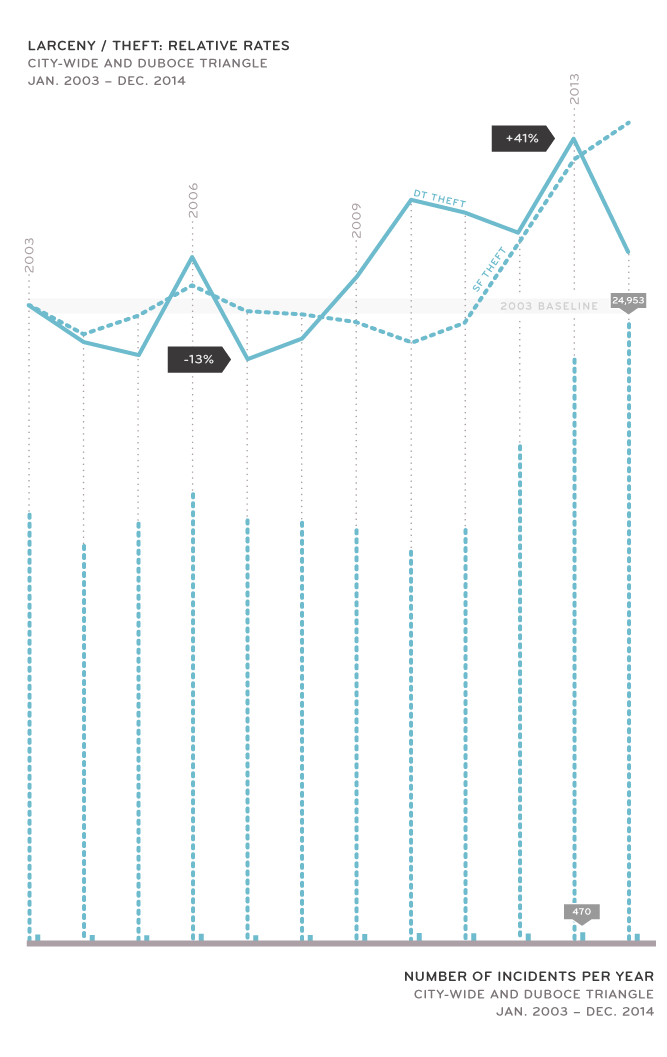
Duboce Triangle has been experiencing a major crime increase in recent years, according to many commenters on social media and local web sites like this one. The murders of Bryan Higgins and Michael Marquez in the last six months or so have only highlighted what many have felt are broader changes for the worse.
For example, reader PerseusSF wrote the following after we reported an assault of a woman at Noe and Henry a couple weeks ago.
It's bad. I just moved out of Duboce Triangle last month after living there for 6 years. My home was burglarized and in general I've seen the neighborhood deteriorate in the last 2 years. It's quite sad.
In a debate on that thread, reader Church&Market responded:
That doesn't change the fact that the area IS becoming more dangerous than it has been in the past, regardless of its relative safety in comparison to other parts of the city. My source is my own observations and experiences over 27 years in the neighborhood."
But what do the official statistics show? That crime has been going down across the city in the past decade, and that generally speaking it has in the Duboce Triangle area as well – the main exception in both cases is larceny, which is increased recently.
Here's a closer look.

We used the city crime incidents data set provided by the SFPD on the Data SF site to create the charts below, using the geographic shape of the neighborhood, above.
Here are the number of assaults and robberies in the neighborhood reported by the SFPD over the years:

Now, here's how that compares to these same crime categories citywide. The graphs below use 2003 as the benchmark to show percentage change, meaning that in 2014 the number of robberies was almost exactly the same as in 2003. The number of assaults in Duboce Triangle in 2014 was higher than almost any year in the past decade, but not by a very large margin.
If you're wondering why the percentage changes create those big spikes for Duboce, it's because it's a relatively small area with relatively few assaults and robberies overall. Even a handful of additional violent crimes per year will generate a large percentage increase (like how a handful could contribute to the qualitative perception of an increase).
To add some perspective on the totals, the second part of the graph immediately below shows the numerical scale of citywide crimes versus Duboce Crimes – you'll have to squint to see the latter.

One takeaway from the above: perhaps Duboce assaults feel more prominent, because they have been increasing in recent years even as assault incidents have been decreasing citywide? Still, the crime rate in Duboce Triangle amounts to about one percent of the city totals.
When we looked at other crime categories in the city database, that we haven't charted here, we generally saw the same sort of small total fluctuations in the Duboce area.
There was one category, however, that looked quite distinct – common theft.

As in the rest of the city, common theft rates have been going up significantly. It is beyond the scope of this article to explain that trend (common explanations, depending on your worldview, could include the introduction of expensive handheld gadgets to the mass market, increasing inequality, reductions in jail time, etc.).
Another variable in all of this data is how the SFPD itself decides to categorize a crime. In the case of the woman who was assaulted and robbed recently, the SFPD officially described it as an "attempted robbery" but the victim described it to us in more sinister terms.
What To Conclude?
Which brings us to some more qualifications for the above data – what is happening in 2015? The city takes at least a couple weeks to begin entering incidents into the public database, and it appears to take longer to complete the entries. February, for example, appears to show a sharp drop in crime, but our understanding is that the data set is simply incomplete.
There's another big factor in why it might feel like crime is increasing – more ways to communicate about it all of the time.
Before the internet, violent crime rates were coincidentally a lot higher but there were no online social networks or online news sites to (*cough*) facilitate conversations about incidents.
And there are other very real factors that don't make it into police reports. As we wrote in August:
The consensus is that yes, things have gotten bad. More trash, more violence, more "shady characters" shooting up and/or masturbating on residents' steps – these seem to be the prevailing concerns. Various factors are credited with these increasingly pervasive quality-of-life issues. The so-called "Mid-Market revival" is cited for pushing so-called "bad actors" into the neighborhood. The Safeway parking lot remains a magnet for "marginal types," despite the recent ousting of the recycling center there. And Duboce Triangle's location itself, where the outskirts of three police districts intersect, means that it's not exactly prominent on the SFPD's radar screen.
There are even more factors to be analyzed here, too, that are beyond the scope of this article. How does population density or the centrality of the neighborhood, or the prevalence of through-transit – all of which are notable features – factor into the crime rates here?
We'll have more crime analysis in the coming months, including the ongoing slowing of violent crime citywide, and what appears to be a citywide uptick in hot prowls.









